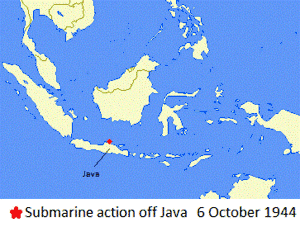Action of 6 October 1944
The Action of 6 October 1944 was an incident of World War II in which a German U-boat was sunk by a Dutch submarine while operating in the Java Sea. The sinking was part of the German U-boat campaign in the Indian and Pacific Oceans.[1]
| Action of 6 October 1944 | |||||||
|---|---|---|---|---|---|---|---|
| Part of World War II, Pacific War | |||||||
 | |||||||
| |||||||
| Belligerents | |||||||
|
|
| ||||||
| Commanders and leaders | |||||||
|
|
| ||||||
| Strength | |||||||
| 1 submarine | 1 submarine | ||||||
| Casualties and losses | |||||||
| none |
23 killed, 1 wounded, 27 captured, 1 submarine sunk | ||||||
| |||||||
Prelude
Due to standard procedures the U-168 had alerted local Japanese units to the details of its departure and arrival, intended course and speed. This was decrypted and included in a FRUMEL report on October 5th, 1944. In response, the Zwaardvisch was ordered to intercept.[2]
Action
Kapitänleutnant Helmuth Pich commanded the boat U-168 during the time of her sinking. The submarine was steaming east to Soerabaja from Batavia where she was to rendezvous with U-537 and U-862. From there, the wolfpack would operate against the western coast of Australia, but before meeting the other U-boats, U-168 was discovered on the surface by the T-class HNLMS Zwaardvisch off the coast of Java in the Java Sea. Lieutenant Commander Hendrikus A. W. Goossens immediately changed course into the direction of the sub and ordered his crew to battle stations. At 06:53, 11 minutes after sighting the Germans, Zwaardvisch released six torpedoes from 900 yd (820 m) away on a 95° track.[1][3]
A few seconds later, an explosion was heard by the Dutch commander so he raised his periscope and observed as the enemy craft began to sink. Goossen also saw several officers and crewmen escaping from the conning tower hatch and they were captured. The torpedo hit U-168's bow and it quickly sank in 220 m (720 ft) of water off Java's northern coast at position 06°20′S 111°28′E. Twenty-three men were killed and 27 became prisoners; because space aboard Zwaardvisch was limited, however, 22 of the detainees were transferred to a fishing boat and allowed to go free. They eventually made it to the shores of Java. The prisoners included Kapitänluetnant Pich, three other officers and one wounded rating. Pich later informed the Dutch commander that his submarine was hit three times though only one torpedo exploded.[1][3] An Australian Navy account gives a description of two torpedoes hitting the U-168 with one failing to detonate and the other exploding in the forward torpedo room.[2]
U-168 is not believed to have made any defensive maneuvers in the action, thus the Germans were sunk likely without realizing they were under attack until the torpedoes hit. The Kriegsmarine was convinced that the sinking of U-168 was the result of "loose talk" due to the crew who brought their Indonesian girlfriends aboard for a goodbye party. They also assumed that the exact position of U-168 was discovered by the Allies long before the engagement, though Dutch reports suggest that they encountered the Germans simply by chance.[1][3]
See also
References
- "German submarine U-168". Dutch Submarines. Archived from the original on 22 November 2010. Retrieved 22 November 2010.
- Royal Australian Navy. "German U-Boat Operations in Australian Waters". www.navy.gov.au.
- Paul Kemp U-boats destroyed: German submarine losses in the World Wars, Naval Institute Press, 1997 ISBN 1-55750-847-X